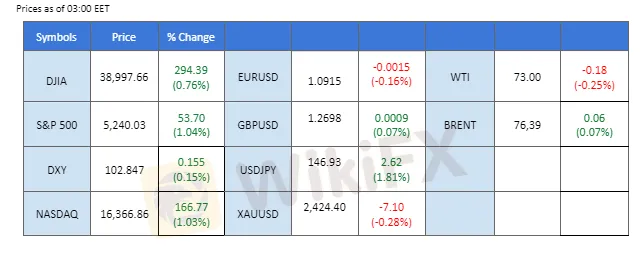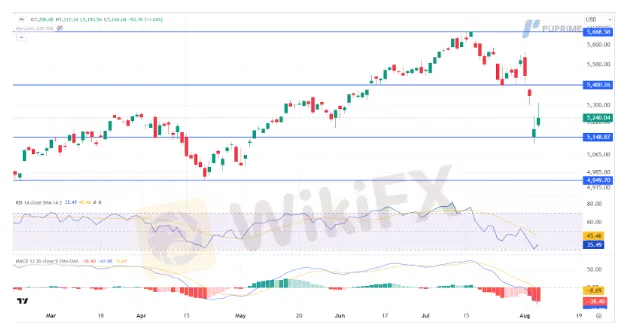简体中文
繁體中文
English
Pусский
日本語
ภาษาไทย
Tiếng Việt
Bahasa Indonesia
Español
हिन्दी
Filippiiniläinen
Français
Deutsch
Português
Türkçe
한국어
العربية
Japanese Yen Eases on BoJ Dovish Statement
Zusammenfassung:The Japanese Yen eased on Wednesday morning after the BoJ Deputy Governor indicated that the Japanese central bank would not raise interest rates if global markets remained unstable. This statement has calmed the market and unwound concerns about Yen carry trades. Meanwhile, the dollar has regained strength, with the dollar index (DXY) climbing above the $103 mark.
Japanese Yen eased in strength as the market reacted to BoJ Dovish tone.
Upbeat job data and Speculative hawkish monetary policy from RBNZ stimulate the New Zealand Dollar.
Equity markets have signs of recovery from their recent sell-down.
Market Summary
The Japanese Yen eased on Wednesday morning after the BoJ Deputy Governor indicated that the Japanese central bank would not raise interest rates if global markets remained unstable. This statement has calmed the market and unwound concerns about Yen carry trades. Meanwhile, the dollar has regained strength, with the dollar index (DXY) climbing above the $103 mark.
Additionally, the New Zealand dollar is in focus as today's New Zealand job data exceeded market expectations, showing an improved unemployment rate and higher wage growth. This suggests that the Reserve Bank of New Zealand may maintain its current restrictive monetary policy for an extended period.
In the equity markets, global equities are expected to ease from recent selling pressure as financial institutions may start buying the dip, providing support for the markets. Asian markets began the day with positive gains, a sentiment likely to be shared with the U.S. market later in the day.
In the commodity market, gold is under pressure due to the strengthening dollar and the rebound in U.S. Treasury yields. Oil prices remain lacklustre as concerns persist over the pessimistic economic outlook and a surprise buildup in U.S. crude stockpiles, as indicated by last night's data.
Current rate hike bets on 18th September Fed interest rate decision:
Source: CME Fedwatch Tool
0 bps (88.5%) VS -25 bps (11.5%)
Market Overview

Economic Calendar
(MT4 System Time)

Source: MQL5
Market Movements

DOLLAR_INDX, H4
With expectations that the Federal Reserve might cut interest rates aggressively, US Treasury 10-year yields are trending downward. Dovish expectations from the Fed have weighed on the appeal of the US Dollar. While some investors re-entered the dollar market post-stabilization, mostly due to dip buying, the longer-term trend for the dollar remains bearish. Downbeat economic performance and Fed rate cut expectations are likely to continue weighing on the demand for the dollar.
The Dollar Index is trading higher following the prior rebound from the support level. MACD has illustrated diminishing bearish momentum, while RSI is at 36, suggesting the index might experience technical correction since the RSI rebounded sharply from oversold territory.
Resistance level: 104.05, 106.05
Support level: 102.40, 100.90

XAU/USD, H4
Gold prices extended their losses as investors sold off gold to convert it into cash to cover margin calls from banks. Following the global equity market and crypto asset selloff, investors shifted their portfolios to these asset classes for dip-buying opportunities. The potential for a trend reversal in the gold market remains data-dependent and influenced by monetary policy expectations. Investors should continue monitoring these catalysts for further trading signals.
Gold prices are trading lower while currently testing the support level. MACD has illustrated increasing bearish momentum, while RSI is at 39, suggesting the commodity might extend its losses after breakout since the RSI stays below the midline.
Resistance level: 2415.00, 2450.00
Support level: 2380.00, 2355.00

GBP/USD,H4
Pound Sterling eased in strength as the country faced social uncertainty due to ongoing riots. Anti-immigrant riots in multiple cities across the U.K. have dented confidence in Sterling. Meanwhile, the U.S. dollar regained strength, bolstered by an improvement in U.S. Treasury yields exerting downside pressure on the pair.
GBP/USD has recorded four weeks of straight decline and is trading toward its lowest level since June, suggesting a bearish bias for the pair. The RSI remains close to the oversold zone, while the MACD has a bearish cross and is edging lower, suggesting the pair remains trading with bearish momentum.
Resistance level: 1.2780, 1.2850
Support level: 1.2630, 1.2550

EUR/USD,H4
The EUR/USD pair faced profit-taking sentiment after surpassing the 1.1000 mark and is struggling to sustain above the next support level near 1.0900. A break below this level would suggest a solid bearish bias for the pair. The euro's strength was hindered by disappointing eurozone Retail Sales figures released yesterday, while the U.S. dollar index reclaimed its $103 territory last night, exerting further downside pressure on the pair.
The pair continues to trade in a downtrend trajectory since it hit its highest level in 2024. The RSI has dropped out from the overbought zone while the MACD has a bearish cross and is edging lower suggest the bullish momentum is easing.
Resistance level: 1.0940, 1.0985
Support level: 1.0895, 1.0853

USD/JPY, H4
The Japanese Yen traded softer after the BoJ released a dovish statement, leading the USD/JPY pair to rebound sharply from its recent bearish trend. The BoJ Deputy Governor claimed that the Japanese central bank would not raise interest rates further if the markets are unstable, which calmed market unease regarding the Yen carry trade.
The pair has rebounded by more than 3% from its recent low level near the 141.80 mark. The RSI has surged sharply from the oversold zone, while the MACD has a bullish cross and is edging toward the zero line from below, suggesting the bearish momentum is easing.
Resistance level: 148.65, 150.10
Support level: 145.27, 143.55

NZD/USD, H4
The NZD/USD pair surged sharply during Wednesday's Sydney session after the release of New Zealand's job data. The data exceeded market expectations, showing an improved unemployment rate and heightened wage growth. This suggests that the Reserve Bank of New Zealand (RBNZ) may stick with its current monetary tightening policy, bolstering the Kiwi's strength.
The pair has broken above its resistance level at 0.5960, suggesting a trend reversal signal. The RSI has been flowing above the 50 level, while the MACD was supported above the zero line, suggesting the pair is trading with bullish momentum.
Resistance level: 0.6020, 0.6080
Support level: 0.5910, 0.5860

S&P 500, H4
The global financial market began stabilising after the aggressive selloff on Monday. Hedge funds and institutional investors bought the dip, supporting the equity market. The S&P 500 index rebounded by 1% on Tuesday after experiencing its worst session in almost two years. Wall Streets chief fear gauge, the CBOE VIX Index, fell from its highest level since 2020 as the market began to digest the previous volatility.
S&P 500 is trading higher following the prior rebound from the support level. MACD has illustrated diminishing bearish momentum, while RSI is at 35, suggesting the index might experience technical correction since the RSI rebounded sharply from oversold territory.
Resistance level: 5400.25, 5670.00
Support level: 5150.00, 4949.70
Haftungsausschluss:
Die Ansichten in diesem Artikel stellen nur die persönlichen Ansichten des Autors dar und stellen keine Anlageberatung der Plattform dar. Diese Plattform übernimmt keine Garantie für die Richtigkeit, Vollständigkeit und Aktualität der Artikelinformationen und haftet auch nicht für Verluste, die durch die Nutzung oder das Vertrauen der Artikelinformationen verursacht werden.
WikiFX-Broker
Aktuelle Nachrichten
Solaris: Weiteres Millionen-Funding noch dieses Jahr – auch Verkauf steht im Raum
Volocopter: Laut Bericht steht das Flugtaxi-Startup kurz vor einer Übernahme aus China
KI-Blase, Milliarden-schwere US-Konkurrenz – warum DeepLs Jarek Kutylowski trotzdem keine Angst hat
Ich war auf der billigsten und der teuersten Kreuzfahrt derselben Reederei – das waren die größten Unterschiede
Goldman Sachs hat 95 Mitarbeiter zu Partnern befördert – wir haben 9 gefragt, wie sie gefeiert haben
Ethereum: Deflationstrend und ETF-Euphorie könnten Rallye entfachen
Nur 100 Euro im Monat: So habe ich 4000 Euro Gewinn in 5 Jahren mit einem ETF-Depot für meine Kinder gemacht
85 Prozent Plus in einer Woche: Die 5 größten Altcoin-Gewinner im Bitcoin-Boom
Solana auf dem Vormarsch: Bald mehr Wert als Ethereum?
Ripple XRP: Die Rally nimmt Fahrt auf – warum der Kurs jetzt explodiert
Wechselkursberechnung


